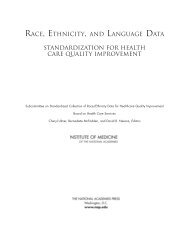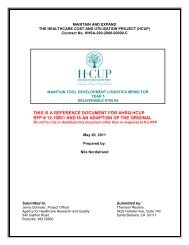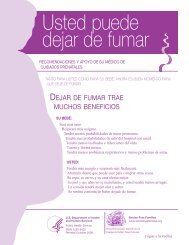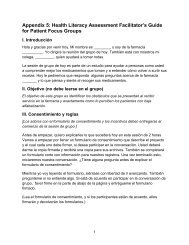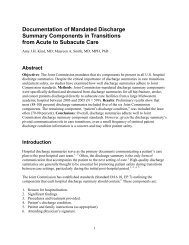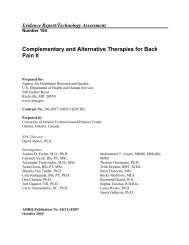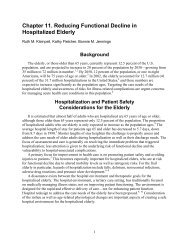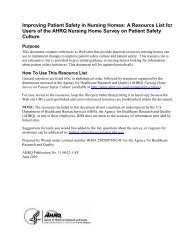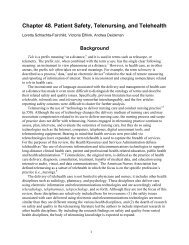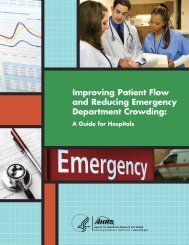Chapter 46. Magnet Environments for Professional Nursing Practice
Chapter 46. Magnet Environments for Professional Nursing Practice
Chapter 46. Magnet Environments for Professional Nursing Practice
Create successful ePaper yourself
Turn your PDF publications into a flip-book with our unique Google optimized e-Paper software.
20<br />
Source<br />
Tigert and<br />
Laschinger<br />
2004 42<br />
Rondeau and<br />
Wagar 2006 39<br />
Environment<br />
Issue/Attribute Related<br />
to Clinical <strong>Practice</strong><br />
<strong>Magnet</strong> characteristics – NWI-<br />
R subscales:<br />
• nurse autonomy<br />
• nurse control over practice<br />
setting<br />
• nurses’ relations with<br />
physicians<br />
Other measures:<br />
Empowerment<br />
• CWEQ-II, 4 subscales:<br />
access to opportunity,<br />
in<strong>for</strong>mation, support, and<br />
resources<br />
• Job Activities Scale-II, 3<br />
items: perceptions of <strong>for</strong>mal<br />
power<br />
• Organizational<br />
Relationships Scale-II, 4<br />
items: perceptions of<br />
in<strong>for</strong>mal power<br />
<strong>Magnet</strong> similarity represented<br />
by employer-of-choice strength<br />
(7 items, e.g., how<br />
establishment views, values,<br />
treats its nursing personnel;<br />
how staff and community view<br />
its treatment of nurses)<br />
Other magnet characteristics<br />
measures:<br />
• high involvement (high<br />
commitment) work practices<br />
(10 items)<br />
• progressive, participatory<br />
decisionmaking workplace<br />
culture (3 items)<br />
• training support (10 items)<br />
Design<br />
Type<br />
Crosssectional<br />
studies<br />
Crosssectional<br />
studies<br />
Study Design<br />
& Study Outcome<br />
Measure(s)<br />
Cross-sectional,<br />
correlational survey<br />
design<br />
Outcomes:<br />
mental health<br />
• State of Mind<br />
subscale (5 items)<br />
from the Pressure<br />
Management<br />
Indicator<br />
• Emotional<br />
Exhaustion<br />
subscale (6 items)<br />
from the Maslach<br />
Burnout Inventory<br />
Cross-sectional survey<br />
Outcomes:<br />
• resident satisfaction<br />
(3 items)<br />
• nurse turnover and<br />
vacancy rates<br />
• nurse satisfaction (3<br />
items)<br />
Study Setting<br />
& Study Population<br />
Ontario, Canada;<br />
Data collected 2001<br />
Survey n = 75 critical care<br />
nurses, a subsample of 239<br />
nurses working in teaching<br />
hospitals (randomly selected<br />
from College of Nurses of<br />
Ontario)<br />
Canada<br />
Data collected 2003<br />
Survey n = 114 nurse<br />
executives sampled from all<br />
long-term care organizations<br />
(nursing homes) in western<br />
Canada with ≥35 beds<br />
Key Finding(s)<br />
The combined effects of<br />
empowerment and magnet<br />
characteristics explained 19% of<br />
the variance in burnout and 12%<br />
of the variance in state of mind.<br />
Empowerment related<br />
significantly and positively to<br />
perceptions of magnet<br />
characteristics; however, only<br />
empowerment was a significant<br />
independent predictor of<br />
emotional exhaustion, and only<br />
magnet characteristics were a<br />
significant predictor of state of<br />
mind.<br />
Higher scores on magnet<br />
employer-of-choice strength were<br />
significantly associated with<br />
• higher resident satisfaction<br />
• lower turnover and vacancy<br />
rates<br />
• higher nurse satisfaction<br />
• high involvement work<br />
practices<br />
• progressive decisionmaking<br />
• nurse training opportunities<br />
and assistance<br />
Patient Safety and Quality: An Evidence-Based Handbook <strong>for</strong> Nurses



